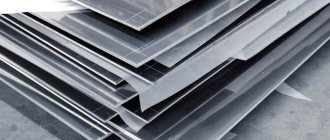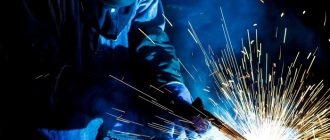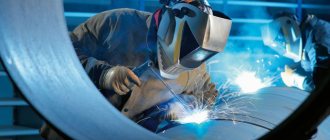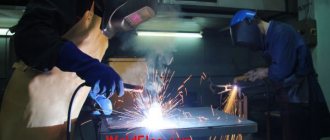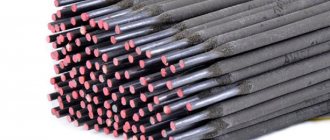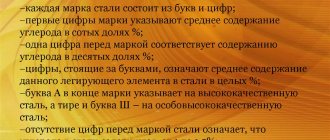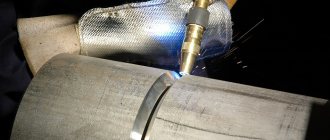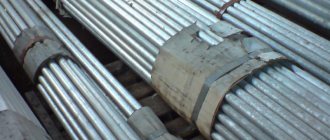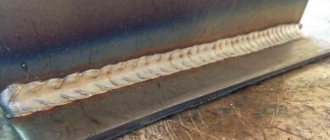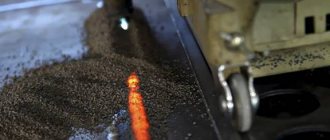At welding of low-carbon and medium-carbon structural steels it is necessary to take into account which steel weldability group a particular steel grade belongs to. Medium carbon structural steels contain more carbon than low carbon steels. And carbon greatly affects the weldability of steels.
Welding low carbon steels
Due to the low carbon concentrate, this type has the following properties :
- high elasticity and plasticity;
- significant impact strength;
- Can be processed well by welding.
Low-carbon steels are widely used in construction and in the production of parts using cold stamping.
Welding technology for low carbon steels
Low carbon steels are best welded. Their connection can be carried out using manual arc welding using coated electrodes. When using this method, it is important to choose the right brand of electrodes, which will ensure a uniform structure of the deposited metal. Welding must be done quickly and accurately. Before starting work, you need to prepare the parts to be connected.
Gas welding is carried out without the use of additional fluxes. Metal wires with a low carbon content are used as filler material. This will help prevent pores from forming.
Gas welding in an argon environment is used to process critical structures.
After welding, the finished structure must be subjected to heat treatment through a normalization operation: the product should be heated to a temperature of approximately 400°C; stand and cool in air. This procedure helps ensure that the steel structure becomes uniform.
Features of welding low-carbon steels
Good weldability of such steels ensures equal strength of the weld with the base metal, as well as the absence of defects.
The weld metal has a reduced carbon content, the proportion of silicon and manganese is increased.
During manual arc welding, the heat-affected area is overheated, which contributes to its slight strengthening.
A weld deposited using multilayer welding is characterized by an increased level of fragility .
The compounds are highly resistant to MCC due to their low carbon concentration.
Types of welding of low-carbon steels
1. The first method for joining low-carbon steels is manual arc welding with coated electrodes. To select the optimal type and brand of consumables, the following requirements must be taken into account:
- weld seam without defects: pores, undercuts, uncooked areas;
- equal strength connection with the main product;
- optimal chemical composition of the weld metal;
- stability of seams under shock and vibration loads, as well as high and low temperatures.
The performer receives the lowest level of stress and deformation when welding in a lower spatial position .
The following types of electrodes are used for welding ordinary structures:
Welding electrodes ANO-6
- ANO-3.
- ANO-4.
- ANO-5.
- ANO-6.
- OZS-3.
- OMM-5.
- TsM-7.
The following grades of welding materials are used for welding critical structures:
- AN-7.
- ANO-1.
- VSP-1.
- WCC-2.
- DSK-50.
- K-5A.
- KPZ-32R.
- MR-1.
- MP-3.
- OZS-2.
- OZS-4.
- OZS-6.
- OMA-2.
- RBU-5.
- SM-5.
- SM-11.
- UONI-13/45.
- UONI-13/55.
- UP-1/45.
- UP-2/45.
- UP-1/55.
- UP-2/55.
- E-138/45N.
- E-138/50N.
- ERS-1.
- ERS-2.
2. Gas welding is carried out in a protective environment of argon, without the use of flux, using metal wire as a filler material.
3. Electroslag welding is carried out using fluxes. Wire and plate electrodes are selected taking into account the composition of the base alloy.
4. Automatic and semi-automatic welding is carried out in a protective environment; pure argon or helium is used, carbon dioxide is often used. CO2 must be of high quality. If the combination of oxygen and carbon is oversaturated with hydrogen or nitrogen, this will lead to pore formation.
5. Automatic submerged arc welding is performed with electrode wire with a diameter of 3-5 mm; semi-automatic – 1.2-2 mm. Welding is performed with direct current of reverse polarity. The welding mode varies significantly.
6. The most optimal method is welding with flux-cored wires . The current strength ranges from 200 to 600 A. Welding is recommended to be carried out in the lower position.
7. For gas shielded , carbon dioxide is used, as well as mixtures of inert gas with oxygen or CO2.
Connecting products less than 2 mm thick. carried out in an atmosphere of inert gases with a tungsten electrode.
To increase arc stability, improve weld formation and reduce the sensitivity of the deposited metal to porosity, mixtures of gases should be used.
Welding in a carbon dioxide atmosphere is intended for working with alloys with a thickness of more than 0.8 mm. and less than 2.0 mm. In the first case, a consumable electrode is used, in the second - graphite or carbon. The type of current is constant, the polarity is reversed. It should be noted that this method is characterized by an increased level of spattering. [ads-pc-2][ads-mob-2]
Types of low alloy steel
Structural low-alloy steels are classified:
Types of low-carbon steels are presented in the table.
Medium-carbon grades (35ХМ, 18Г2AF, 17ГС) contain more than 0.25% carbon and are used after heat treatment.
Heat-resistant metals have increased strength when working at high temperatures. They are used in the manufacture of metal elements of energy devices.
Due to the higher strength of low-alloy steels (compared to carbon structural steels), their use in the production of welded structures reduces weight and saves metal.
Due to these properties, the materials are used in railcar and shipbuilding, construction and other areas of industry.
Welding medium carbon steels
Medium carbon steels are used in cases where high mechanical properties are required. These alloys can be forged.
They are also used for parts produced by cold plastic deformation; are characterized as calm, which allows them to be used in mechanical engineering.
Steels with a carbon content of 0.4 to 0.6% are ideal for the manufacture of carriage wheels and axles, and railway rails.
Welding technology for medium carbon steels
These alloys are not welded as well as low carbon steels. This is due to several difficulties:
- lack of equal strength of the base and deposited metals;
- high level of risk of formation of large cracks and non-plastic structures in the heat-affected zone;
- low resistance to the formation of crystallization defects.
However, these problems can be solved quite easily by following these recommendations :
- the use of electrodes and wire with a low carbon content;
- welding rods must have an increased deposition rate;
- to ensure the lowest degree of penetration of the base metal, the edges should be cut, the optimal welding mode should be set, and filler wire should be used;
- preliminary and accompanying heating of workpieces.
The carbon steel welding technology, when following the above recommendations, does not reveal any problems or difficulties.
Features of welding medium-carbon steels
Before welding, the product must be cleaned of dirt, rust, oil, scale and other contaminants, which are a source of hydrogen and can contribute to the formation of pores and cracks in the seam. The edges and adjacent areas with a width of no more than 10 mm are subject to cleaning. This guarantees the strength of the connection under various types of loads.
Assembling parts for welding requires maintaining a gap, the width of which depends on the thickness of the product and should be 1-2 mm. more than when working with well-welded materials.
If the thickness of a medium carbon steel product exceeds 4 mm, edge cutting must be performed.
the welding mode should be selected correctly . The correctness of the choice can be confirmed by measuring the hardness of the deposited metal. In optimal mode, it should not be higher than 350 HV.
Responsible nodes are connected in two or more passes. Frequent arc breaks, burns (burning) of the base metal and crater formation on it are not allowed.
Welding of critical structures is carried out with preheating from 100 to 400°C. The higher the carbon content and thickness of the parts, the higher the temperature should be.
Cooling should be slow, the product should be placed in a thermostat or covered with heat-insulating material.
Types of welding of medium carbon steels
Welding of medium-carbon steels can be carried out in several ways, which we will discuss below.
1. Manual arc welding is performed with electrodes with a basic type of coating, ensuring a low hydrogen content in the deposited metal. Most often, performers use the following electrodes for welding carbon steels:
- ANO-7.
- ANO-8.
- ANO-9.
- OZS-2.
- UONI-13/45.
- UONI-13/55.
- UONI-13/65.
of UONI welding materials guarantees an increase in the joint’s resistance to cracking and also ensures the strength of the seam.
The following nuances should be taken into account:
- instead of transverse movements, longitudinal ones must be performed;
- it is necessary to weld the craters , otherwise the risk of crack formation increases;
- It is recommended to heat treat the seam.
2. Gas welding of thin-sheet format carbon steels is performed using the left-hand method using wire, and a normal welding flame . The average acetylene consumption is 120-150 l/h per 1 mm. thickness of the alloy being welded. In order to reduce the risk of crystallization cracks, welding materials with a carbon content of no more than 0.2-0.3% should be used.
Thick-walled products should be joined using the right-hand gas welding method, which is characterized by higher productivity. Acetylene calculation is also 120-150 l/h. To avoid overheating of the working area, the flow rate must be reduced.
Gas welding of carbon steels also includes the following features :
- reduction of oxidation in the weld pool is achieved by using a flame with a slight excess of acetylene;
- the use of fluxes has a positive effect on the process;
- To avoid brittleness in the heat-affected zone, cooling is slowed down by preheating to 200-250°C or subsequent tempering at a temperature of 600-650°C.
After welding, the product can be heat treated or forged. These operations significantly improve the properties.
The technology of gas welding of carbon steels has been developed to obtain joints with the necessary mechanical properties. Therefore, it is important for the performer to take into account these specific features.
3. The technology of submerged arc welding of carbon steels involves the use of welding wire and fused fluxes: AN-348-A and OSTS-45. Welding is carried out at low current values. This allows you to “saturate” the deposited metal with the required level of silicon and manganese. These elements intensively transfer from the flux to the weld metal.
Advantages of this method: high productivity; the deposited metal is reliably protected from interaction with air, which ensures high quality of the connection; the efficiency of the process is achieved due to low spattering and due to the reduction of metal losses due to waste; arc stability guarantees a fine-flaky weld surface.
4. Performers often use the argon arc welding method with a non-consumable electrode. The main difficulty when welding medium-carbon steels using this method is that it is difficult to avoid the formation of pores due to slight deoxidation of the base metal. To solve this problem, it is necessary to reduce the proportion of base metal in the deposit. To do this, it is necessary to correctly select the modes for welding carbon steel with argon. Welding is carried out with direct current of straight polarity.
The voltage value is set depending on the thickness of the structure for single-pass welding and based on the height of the bead, which is 2.0-2.5 mm for multi-pass welding. Approximate current indicators can be determined as follows: 30-35 A per 1 mm. tungsten rod. [ads-pc-3][ads-mob-3]
Process Features
Low-alloy steel is a material belonging to the group of satisfactorily weldable metals that are joined by almost all types of welding.
- equal seam strength;
- obtaining the required form;
- no defects.
Welding low-alloy steel is more difficult than low-carbon structural steel. It is more sensitive to thermal influences. It should be taken into account that a content of more than 0.25% carbon in the material can lead to the formation of hardening structures and cracks in the weld, and carbon burnout can lead to the formation of pores.
To avoid the formation of hardening martensitic structures, the part is heated, multilayer welding is used, observing a minimum time interval between the application of metal layers to the seam. The material of the coated electrodes is selected with a low content of phosphorus, carbon and sulfur. This helps to increase the resistance of the seam against crystallization cracks.
Connection of chromium-silicon-manganese steels
This type of low alloy steel is also called chromansil. The composition includes carbon 0.17-0.4%, manganese 0.8-1.1%, silicon and chromium - 0.9-1.2%. The material is inexpensive, has good elasticity and strength, and can withstand vibration. Disadvantage: poor heat resistance.
Welding high carbon steels
Demonstration welding of steel from springs with Zeller 655 electrode
The high carbon content in steels of this type makes them, as a rule , unsuitable for the manufacture of welded structures. They are characterized by low ductility and therefore have limited use.
The need for high-carbon steels arises when carrying out repair work, in the production of springs, cutting, drilling, woodworking and other tools, high-strength wire, as well as in those products that must have high wear resistance and strength.
Welding technology for high carbon steels
Welding is possible, as a rule, with preliminary and concomitant heating to 150-400°C, as well as subsequent heat treatment . This is due to the tendency of this type of alloy to become brittle, sensitive to hot and cold cracks, and chemical heterogeneity of the weld.
For your information! Exceptions are possible if you use specialized electrodes for dissimilar steels. See photo and caption below.
- After heating, it is necessary to perform annealing , which must be carried out until the product cools down to a temperature of 20°C.
- An important condition is the inadmissibility of welding in drafts and at ambient temperatures below 5°C.
- To increase the strength of the connection, it is necessary to create smooth transitions from one to another metal being welded.
- Good results are achieved when welding with narrow beads , with cooling of each deposited layer.
- The contractor should also follow the rules provided for joining medium-carbon alloys.
This is a demonstration sample (spring, files, bearing and food-grade stainless steel are welded together). If you do not pay attention to the quality of the seams, the welds were not made by professional welders, the photo confirms that welding of “non-weldable” steels is quite possible.
Video
Features of welding high-carbon steels
The working surface must be cleaned of various types of contaminants: rust, scale, mechanical irregularities and dirt. The presence of contaminants can lead to the formation of pores.
Structures made of high-carbon steels need to be cooled slowly , in air, to normalize the structure.
Preheating critical products to 400°C allows one to achieve the required strength.
Types of welding of high-carbon steels
1. The optimal option for the welding process is manual arc welding using coated electrodes. Working with high-carbon steels has a large number of specific characteristics. Therefore, welding of high-carbon steel is carried out with specially designed electrodes, for example, NR-70. Welding is carried out with direct current of reverse polarity.
2. Submerged arc welding is also used to join this type of alloys. It is quite difficult to evenly coat the work area with flux manually. Therefore, in most cases, automatic technology is used. The molten flux forms a dense shell and prevents the influence of harmful atmospheric factors on the weld pool. For submerged arc welding, transformers are used that produce alternating current. These devices allow you to create a stable arc. The main advantage of this method is the small loss of metal due to small spattering.
It is important to note that the gas welding method is not recommended . The process is characterized by the burning of a large amount of carbon, resulting in the formation of hardening structures that negatively affect the quality of the weld.
However, if ordinary structures are welded, then the use of this method is possible. The connection is made on a normal or low flame, the power of which does not exceed 90 m3 of acetylene per hour. The product must be heated to 300°C. Welding is carried out using the left-hand method , which makes it possible to reduce the time the metal is in the molten state and the duration of its overheating.
Technology
Manual arc welding is the most common method of joining materials for welding structures, in which manually:
- arc is excited;
- the electrode is fed and moved.
The work is carried out with coated electrodes. The method involves burning a welding arc from an electrode onto the object being welded. The edges of the product are melted, the metal of the electrode rod and the electrode coating are melted. The base metal and electrode material crystallize to form a weld.
Scheme of manual arc welding with covered electrodes
Welding stainless steel and carbon steel
Welding corrosion-resistant and carbon steels is a prime example of joining dissimilar materials.
Preliminary and concomitant heating of products to a temperature of approximately 600°C will make it possible to obtain a seam with a more uniform structure. After work, you need to carry out heat treatment, this will help avoid the formation of cracks. For welding stainless steel and low-carbon steels, two methods are used in practice, which involve the use of welding rods:
- high-alloy steel electrodes or nickel-based electrodes fill the weld seam;
- The edges of the low-carbon steel product are welded with alloy electrodes, then the clad layer, the stainless steel edges are welded with special electrodes for stainless steel.
Welding of stainless and carbon steels can also be carried out using the argon arc method. However, this technology is used extremely rarely and only for working with particularly critical structures.
The contractor can also make a connection using semi-automatic welding using a metal electrode in a protective environment of inert gases.
Equipment selection
The type and operational features of welding equipment for working with carbon steels vary widely and depend on factors such as:
- selected welding method;
- workpiece characteristics;
- required seam quality;
- design welding mode;
- features of the external environment;
- required performance;
- financial and economic criteria.
Most often, carbon steels are joined using one of the electric arc welding methods. If manual welding is expected and the amount of work is relatively small, you can use a conventional welding inverter, the main advantages of which are its compactness and low cost. A good choice would be the Fubag IR 200, Wester MMA-VRD 200, Elitech AIS 200, Resanta SAI-220 and others.
Approximate cost of Resanta SAI-220 devices on Yandex.market
Otherwise, it is better to give preference to industrial transformers with higher performance, for example, Kavik TDM-252U2 (250 A, 12 kW) or Brima TDM1-315-1 (315 A, 24 kW). In areas where connection to the electrical network is impossible or difficult, welding generators equipped with internal combustion engines are used.
For semi-automatic welding in shielding gases or under a layer of flux, specialized welding machines of a combined design are used, which provide the generation of welding current, as well as the supply of shielding gas and a consumable electrode to the welding zone (in addition, filler wire can be supplied). In the niche of budget models, the leader is Aurora Overman 180, in the top segment – Blueweld Starmig 210 Dual Synergic.
Approximate cost of Aurora overman devices on Yandex.market
For gas welding, you will need oxygen and acetylene cylinders with pressure gauges, flexible hoses and a torch that allows you to adjust the proportional ratio of gases. Equipment for alternative types of welding is specific; it belongs to industrial devices and is extremely rarely used in everyday life.
